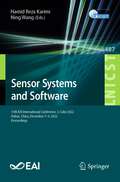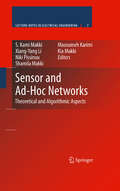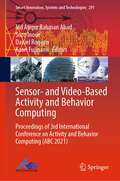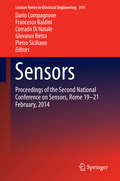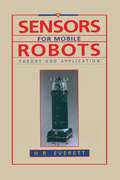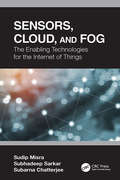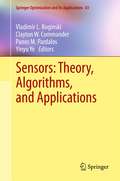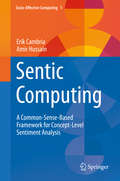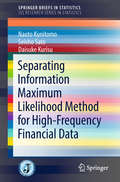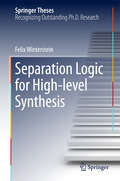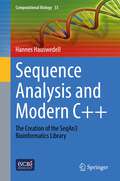- Table View
- List View
Sensor Systems and Software: 13th EAI International Conference, S-Cube 2022, Dalian, China, December 7-9, 2022, Proceedings (Lecture Notes of the Institute for Computer Sciences, Social Informatics and Telecommunications Engineering #487)
by Ning Wang Hamid Reza KarimiThis book constitutes the proceedings of the 13th International Conference on Sensor Systems and Software, S-Cube 2022, which was held in Dalian, China, in December 7-9, 2022. The 16 revised full papers in this book were selected from 42 submissions and are organized in three thematic sessions on sensor technology for marine systems; resilience control systems; and applications.
Sensor and Ad-Hoc Networks
by Xiang-Yang Li Kia Makki S. Kami Makki Niki Pissinou Masoumeh Karimi Shamila MakkiThis book brings together leading researchers and developers in the field of wireless sensor networks to explain the special problems and challenges of the algorithmic aspects of sensor and ad-hoc networks. The book also fosters communication not only between the different sensor and ad-hoc communities, but also between those communities and the distributed systems and information systems communities. The topics addressed pertain to the sensors and mobile environment.
Sensor- and Video-Based Activity and Behavior Computing: Proceedings of 3rd International Conference on Activity and Behavior Computing (ABC 2021) (Smart Innovation, Systems and Technologies #291)
by Sozo Inoue Daniel Roggen Md Atiqur Rahman Ahad Kaori FujinamiThis book presents the best-selected research papers presented at the 3rd International Conference on Activity and Behavior Computing (ABC 2021), during 20–22 October 2021. The book includes works related to the field of vision- and sensor-based human action or activity and behavior analysis and recognition. It covers human activity recognition (HAR), action understanding, gait analysis, gesture recognition, behavior analysis, emotion, and affective computing, and related areas. The book addresses various challenges and aspects of human activity recognition—both in sensor-based and vision-based domains. It can be considered as an excellent treasury related to the human activity and behavior computing.
Sensor-Based Activity Recognition and Artificial Intelligence: 9th International Workshop, iWOAR 2024, Potsdam, Germany, September 26–27, 2024, Proceedings (Lecture Notes in Computer Science #15357)
by Arjan Kuijper Orhan Konak Bert Arnrich Gerald Bieber Sebastian FudickarThis book constitutes the proceedings of the 9th International Workshop on Sensor-Based Activity Recognition and Artificial Intelligence, iWOAR 2024, held in Potsdam, Germany, during September 26–27, 2024. The 15 full papers and 4 short papers presented here were carefully reviewed and selected from 28 submissions. These papers have been categorized into the following topical sections: Advances in Human Activity Recognition; Applications in Vision-Based Recognition; Wearable Devices and Health Monitoring; Novel AI and Machine Learning Approaches; Short Papers: Emerging Topics in Sensor-Based Systems.
Sensorimotor Integration in the Whisker System
by Patrik Krieger Alexander GrohSensorimotor integration, the dynamic process by which the sensory and motor systems communicate with each other, is crucial to humans' and animals' ability to explore and react to their environment. This book summarizes the main aspects of our current understanding of sensorimotor integration in 10 chapters written by leading scientists in this active and ever-growing field. This volume focuses on the whisker system, which is an exquisite model to experimentally approach sensorimotor integration in the mammalian brain. In this book, authors examine the whisker system on many different levels, ranging from the building blocks and neuronal circuits to sensorimotor behavior. Neuronal coding strategies, comparative analysis as well as robotics illustrate the multiple facets of this research and its broad impact on fundamental questions about the neurobiology of the mammalian brain.
Sensors
by Corrado Di Natale Pietro Siciliano Dario Compagnone Francesco Baldini Giovanni BettaThis book contains a selection of papers presented at the Second National Conference on Sensors held in Rome 19-21 February 2014. The conference highlighted state-of-the-art results from both theoretical and applied research in the field of sensors and related technologies. This book presents material in an interdisciplinary approach, covering many aspects of the disciplines related to sensors, including physics, chemistry, materials science, biology and applications.
Sensors and Protocols for Industry 4.0: Industrial Applications of Maker Tech (Maker Innovations Series)
by G. R. Kanagachidambaresan Bharathi NThis book Identifies the right sensors and single board computers for any application to achieve the best performance in Industry 4.0 settings and applications. You’ll see what technologies apply the IIoT with elegant efficiency to drastically improve remote monitoring and controlling, decision making, and preventative maintenance. Start by learning exactly what Industry 4.0 is and advance your knowledge from simple Internet of Things projects to full-on Industrial IoT deployment. You'll automate advanced processes, incorporate professional procedures, and take your IoT skills to a professional level. Then move into the protocols and standards expected for industrial applications of sensors at an industrial level. Match the right SBCs to the right use cases and sensor technologies to optimize efficiency and ensure peak performance. Then move into setting up a smart factory and monitoring your supply chain with tech. Finally, you'll dive into programming with the Node-Red platform and Python packages for CPS. By the end of this book, you’ll have jumped from simple, home-based IoT systems up to industrial and professional applications. Conquer your supply chain and both forward and backward processes with accessible Maker tech! What You'll Learn Support industrial applications of SBCs and Maker tech Achieve peak performance by combining the right sensors with the right processing boards Improve remote monitoring and controlling drastically for better decision making and preventative maintenance Who This Book Is For Students and aspiring professionals working with Internet of things technologies moving towards industrial applications. Prerequisite knowledge in basic Internet of Things, simple python concepts, automation, and industry procedures is required for this book. Engineers and scientists who are pursuing research and contributing to industrial internet of things might also benefit.
Sensors for Mobile Robots
by H.R. EverettThe author compiles everything a student or experienced developmental engineer needs to know about the supporting technologies associated with the rapidly evolving field of robotics.From the table of contents: Design Considerations * Dead Reckoning * Odometry Sensors * Doppler and Inertial Navigation * Typical Mobility Configurations * Tactile and
Sensors, Cloud, and Fog: The Enabling Technologies for the Internet of Things
by Sudip Misra Subhadeep Sarkar Subarna ChatterjeeThis book provides an in-depth understanding of Internet of Things (IoT) technology. It highlights several of today's research and technological challenges of translating the concept of the IoT into a practical, technologically feasible, and business-viable solution. It introduces two novel technologies--sensor-cloud and fog computing--as the crucial enablers for the sensing and compute backbone of the IoT. The book discusses these two key enabling technologies of IoT that include a wide range of practical design issues and the futuristic possibilities and directions involving sensor networks and cloud and fog computing environments towards the realization and support of IoT. Classroom presentations and solutions to end of chapter questions are available to instructors who use the book in their classes.
Sensors: Proceedings Of The Second National Conference On Sensors, Rome 19-21 February 2014 (Lecture Notes in Electrical Engineering #319)
by Marco Rossi Corrado Di Natale Pietro Siciliano Vittorio Ferrari Bruno Andò Vincenzo Marletta Francesco Baldini Giovanna Marrazza Valeria Militello Giorgia Miolo Lorenzo ScaliseThis book contains a selection of papers presented at the Second National Conference on Sensors held in Rome 19-21 February 2014. The conference highlighted state-of-the-art results from both theoretical and applied research in the field of sensors and related technologies. This book presents material in an interdisciplinary approach, covering many aspects of the disciplines related to sensors, including physics, chemistry, materials science, biology and applications.
Sensors: Theory, Algorithms, and Applications (Springer Optimization and Its Applications #61)
by Panos M. Pardalos Vladimir L. Boginski Yinyu Ye Clayton W. CommanderThe objective of this book is to advance the current knowledge of sensor research particularly highlighting recent advances, current work, and future needs. The goal is to share current technologies and steer future efforts in directions that will benefit the majority of researchers and practitioners working in this broad field of study.
Sentic Computing
by Amir Hussain Erik CambriaIn this book common sense computing techniques are further developed and applied to bridge the semantic gap between word-level natural language data and the concept-level opinions conveyed by these. In particular, the ensemble application of graph mining and multi-dimensionality reduction techniques is exploited on two common sense knowledge bases to develop a novel intelligent engine for open-domain opinion mining and sentiment analysis. The proposed approach, termed sentic computing, performs a clause-level semantic analysis of text, which allows the inference of both the conceptual and emotional information associated with natural language opinions and, hence, a more efficient passage from (unstructured) textual information to (structured) machine-processable data.
Sentiment Analysis
by Bing LiuSentiment analysis and opinion mining is the field of study that analyzes people's opinions, sentiments, evaluations, attitudes, and emotions from written language. It is one of the most active research areas in natural language processing and is also widely studied in data mining, Web mining, and text mining. In fact, this research has spread outside of computer science to the management sciences and social sciences due to its importance to business and society as a whole. The growing importance of sentiment analysis coincides with the growth of social media such as reviews, forum discussions, blogs, micro-blogs, Twitter, and social networks. For the first time in human history, we now have a huge volume of opinionated data recorded in digital form for analysis. Sentiment analysis systems are being applied in almost every business and social domain because opinions are central to almost all human activities and are key influencers of our behaviors. Our beliefs and perceptions of reality, and the choices we make, are largely conditioned on how others see and evaluate the world. For this reason, when we need to make a decision we often seek out the opinions of others. This is true not only for individuals but also for organizations. This book is a comprehensive introductory and survey text. It covers all important topics and the latest developments in the field with over 400 references. It is suitable for students, researchers and practitioners who are interested in social media analysis in general and sentiment analysis in particular. Lecturers can readily use it in class for courses on natural language processing, social media analysis, text mining, and data mining. Lecture slides are also available online. Table of Contents: Preface / Sentiment Analysis: A Fascinating Problem / The Problem of Sentiment Analysis / Document Sentiment Classification / Sentence Subjectivity and Sentiment Classification / Aspect-Based Sentiment Analysis / Sentiment Lexicon Generation / Opinion Summarization / Analysis of Comparative Opinions / Opinion Search and Retrieval / Opinion Spam Detection / Quality of Reviews / Concluding Remarks / Bibliography / Author Biography
Sentiment Analysis Unveiled: Techniques, Applications, and Innovations (Edge AI in Future Computing)
by Rohit Tanwar Varun Sapra Neha NandalThis book is a comprehensive exploration into the realm of sentiment analysis. From deciphering customer sentiments for businesses to understanding public opinions on social media or predicting market trends, the applications are multifaceted and impactful.Sentiment Analysis Unveiled: Techniques, Applications, and Innovations is more than just algorithms and models; it’s about unraveling the emotions, opinions, and perceptions encapsulated within the vast sea of textual data. This book explores topics from opinion mining, social media analysis, deep learning, security concerns, and healthcare systems, and it also delves into the ethical and legal implications of sentiment analysis. Through practical examples, case studies, and discussions on cutting‑edge innovations, the editors aim is to provide a holistic view that empowers you to navigate this field confidently. It involves the analysis of user‑generated content, deciphering sentiments expressed on platforms like Twitter and Facebook, and provides valuable insights into public opinion, brand perception, and emerging trends in the digital landscape.This book is intended for professionals, researchers, and scientists in the field of artificial intelligence and sentiments analysis; it will serve as a valuable resource for both beginners and experienced professionals in the field.
Sentiment Analysis and Deep Learning: Proceedings of ICSADL 2022 (Advances in Intelligent Systems and Computing #1432)
by Ke-Lin Du Klimis Ntalianis Subarna ShakyaThis book gathers selected papers presented at International Conference on Sentimental Analysis and Deep Learning (ICSADL 2022), jointly organized by Tribhuvan University, Nepal and Prince of Songkla University, Thailand during 16 – 17 June, 2022. The volume discusses state-of-the-art research works on incorporating artificial intelligence models like deep learning techniques for intelligent sentiment analysis applications. Emotions and sentiments are emerging as the most important human factors to understand the prominent user-generated semantics and perceptions from the humongous volume of user-generated data. In this scenario, sentiment analysis emerges as a significant breakthrough technology, which can automatically analyze the human emotions in the data-driven applications. Sentiment analysis gains the ability to sense the existing voluminous unstructured data and delivers a real-time analysis to efficiently automate the business processes.
Sentiment Analysis and Ontology Engineering
by Witold Pedrycz Shyi-Ming ChenThis editedvolume provides the reader with a fully updated, in-depth treatise on the emergingprinciples, conceptual underpinnings, algorithms and practice of ComputationalIntelligence in the realization of concepts and implementation of models ofsentiment analysis and ontology -oriented engineering. The volume involves studies devotedto key issues of sentiment analysis, sentiment models, and ontologyengineering. The book is structured into three main parts. The first partoffers a comprehensive and prudently structured exposure to the fundamentals ofsentiment analysis and natural language processing. The second part consists ofstudies devoted to the concepts, methodologies, and algorithmic developmentselaborating on fuzzy linguistic aggregation to emotion analysis, carrying outinterpretability of computational sentiment models, emotion classification,sentiment-oriented information retrieval, a methodology of adaptive dynamics inknowledge acquisition. The third part includes a plethora of applicationsshowing how sentiment analysis and ontologies becomes successfully applied toinvestment strategies, customer experience management, disaster relief,monitoring in social media, customer review rating prediction, and ontologylearning. This book isaimed at a broad audience of researchers and practitioners. Readers involved inintelligent systems, data analysis, Internet engineering, ComputationalIntelligence, and knowledge-based systems will benefit from the exposure to thesubject matter. The book may also serveas a highly useful reference material for graduate students and seniorundergraduate students.
Sentiment Analysis and its Application in Educational Data Mining (SpringerBriefs in Applied Sciences and Technology)
by Soni SwetaThe book delves into the fundamental concepts of sentiment analysis, its techniques, and its practical applications in the context of educational data. The book begins by introducing the concept of sentiment analysis and its relevance in educational settings. It provides a thorough overview of the various techniques used for sentiment analysis, including natural language processing, machine learning, and deep learning algorithms. The subsequent chapters explore applications of sentiment analysis in educational data mining across multiple domains. The book illustrates how sentiment analysis can be employed to analyze student feedback and sentiment patterns, enabling educators to gain valuable insights into student engagement, motivation, and satisfaction. It also examines how sentiment analysis can be used to identify and address students' emotional states, such as stress, boredom, or confusion, leading to more personalized and effective interventions. Furthermore, the book explores the integration of sentiment analysis with other educational data mining techniques, such as clustering, classification, and predictive modeling. It showcases real-world case studies and examples that demonstrate how sentiment analysis can be combined with these approaches to improve educational decision-making, curriculum design, and adaptive learning systems.
Sentiment Analysis in the Medical Domain
by Kerstin DeneckeSentiment analysis deals with extracting information about opinions, sentiments, and even emotions conveyed by writers towards topics of interest. Medical sentiment analysis refers to the identification and analysis of sentiments or emotions expressed in free-textual documents with a scope on healthcare and medicine. This fascinating problem offers numerous application areas in the domain of medicine, but also research challenges. The book provides a comprehensive introduction to the topic. The primary purpose is to provide the necessary background on medical sentiment analysis, ranging from a description of the notions of medical sentiment to use cases that have been considered already and application areas of relevance. Medical sentiment analysis uses natural language processing (NLP), text analysis and machine learning to realise the process of extracting and classifying statements regarding expressed opinion and sentiment. The book offers a comprehensive overview on existing methods of sentiment analysis applied to healthcare resources or health-related documents. It concludes with open research avenues providing researchers indications which topics still have to be developed in more depth.
Sentiment Analysis: Mining Opinions, Sentiments, and Emotions (Studies in Natural Language Processing)
by Bing LiuSentiment analysis is the computational study of people's opinions, sentiments, emotions, moods, and attitudes. This fascinating problem offers numerous research challenges, but promises insight useful to anyone interested in opinion analysis and social media analysis. This comprehensive introduction to the topic takes a natural-language-processing point of view to help readers understand the underlying structure of the problem and the language constructs commonly used to express opinions, sentiments, and emotions. The book covers core areas of sentiment analysis and also includes related topics such as debate analysis, intention mining, and fake-opinion detection. It will be a valuable resource for researchers and practitioners in natural language processing, computer science, management sciences, and the social sciences. In addition to traditional computational methods, this second edition includes recent deep learning methods to analyze and summarize sentiments and opinions, and also new material on emotion and mood analysis techniques, emotion-enhanced dialogues, and multimodal emotion analysis.
Sentiment-Analyse deutschsprachiger Meinungsäußerungen: Grundlagen, Methoden und praktische Umsetzung
by Melanie Siegel Melpomeni AlexaDer Zugang zu Information ist durch das Internet erheblich verändert und erleichtert worden. Gleichzeitig gibt es seit dem Web 2.0 die Möglichkeit für alle Internet-Nutzer, selbst Inhalte beizusteuern, indem sie in Foren schreiben, oder Twitter, Xing, LinkedIn, Facebook oder andere soziale Medien nutzen und auf veröffentliche Posts z. B. durch Kommentare reagieren. Diese Fülle an Informationen und Meinungen ist ein wertvoller und in der Regel sehr großer Datenschatz, den man nur mit automatischen Verfahren sinnvoll nutzen kann.Die automatische Analyse von Meinungsäußerungen gehört in die Anwendungsbereiche Informationsextraktion und Inhaltsanalyse sowie Text Mining. Aus Texten von Internet-Nutzern werden Informationen extrahiert und analysiert, wie sie sich zu bestimmten Themen, Produkten oder Ereignissen äußern.Dieses Buch gibt eine systematische Einführung in Methoden der automatischen Analyse von Meinungsäußerungen und zeigt die Anwendung der beschriebenen Methoden in Programmierübungen. Der Fokus liegt dabei auf deutschsprachige Daten, also auf linguistischen Ressourcen sowie Methoden zur automatischen Analyse für die deutsche Sprache. Viele Übungsaufgaben sowie in Python implementierte Programmierbeispiele und -aufgaben machen das Buch zum optimalen Begleiter für Studium und Selbststudium.
Sentimental Analysis and Deep Learning: Proceedings of ICSADL 2021 (Advances in Intelligent Systems and Computing #1408)
by Ke-Lin Du Valentina Emilia Balas Subarna Shakya Sinchai KamolphiwongThis book gathers selected papers presented at the International Conference on Sentimental Analysis and Deep Learning (ICSADL 2021), jointly organized by Tribhuvan University, Nepal; Prince of Songkla University, Thailand; and Ejesra during June, 18–19, 2021. The volume discusses state-of-the-art research works on incorporating artificial intelligence models like deep learning techniques for intelligent sentiment analysis applications. Emotions and sentiments are emerging as the most important human factors to understand the prominent user-generated semantics and perceptions from the humongous volume of user-generated data. In this scenario, sentiment analysis emerges as a significant breakthrough technology, which can automatically analyze the human emotions in the data-driven applications. Sentiment analysis gains the ability to sense the existing voluminous unstructured data and delivers a real-time analysis to efficiently automate the business processes. Meanwhile, deep learning emerges as the revolutionary paradigm with its extensive data-driven representation learning architectures. This book discusses all theoretical aspects of sentimental analysis, deep learning and related topics.
Separating Information Maximum Likelihood Method for High-Frequency Financial Data (SpringerBriefs in Statistics #0)
by Naoto Kunitomo Seisho Sato Daisuke KurisuThis book presents a systematic explanation of the SIML (Separating Information Maximum Likelihood) method, a new approach to financial econometrics.Considerable interest has been given to the estimation problem of integrated volatility and covariance by using high-frequency financial data. Although several new statistical estimation procedures have been proposed, each method has some desirable properties along with some shortcomings that call for improvement. For estimating integrated volatility, covariance, and the related statistics by using high-frequency financial data, the SIML method has been developed by Kunitomo and Sato to deal with possible micro-market noises.The authors show that the SIML estimator has reasonable finite sample properties as well as asymptotic properties in the standard cases. It is also shown that the SIML estimator has robust properties in the sense that it is consistent and asymptotically normal in the stable convergence sense when there are micro-market noises, micro-market (non-linear) adjustments, and round-off errors with the underlying (continuous time) stochastic process. Simulation results are reported in a systematic way as are some applications of the SIML method to the Nikkei-225 index, derived from the major stock index in Japan and the Japanese financial sector.
Separation Logic for High-level Synthesis
by Felix WintersteinThis book presents novel compiler techniques, which combine a rigorous mathematical framework, novel program analyses and digital hardware design to advance current high-level synthesis tools and extend their scope beyond the industrial 'state of the art'. Implementing computation on customised digital hardware plays an increasingly important role in the quest for energy-efficient high-performance computing. Field-programmable gate arrays (FPGAs) gain efficiency by encoding the computing task into the chip's physical circuitry and are gaining rapidly increasing importance in the processor market, especially after recent announcements of large-scale deployments in the data centre. This is driving, more than ever, the demand for higher design entry abstraction levels, such as the automatic circuit synthesis from high-level languages (high-level synthesis). The techniques in this book apply formal reasoning to high-level synthesis in the context of demonstrably practical applications.
Sequence Alignment: Methods, Models, Concepts, and Strategies
by Michael S. RosenbergThe sequencing of the human genome involved thousands of scientists but used relatively few tools. Today, obtaining sequences is simpler, but aligning the sequences--making sure that sequences from one source are properly compared to those from other sources--remains a complicated but underappreciated aspect of comparative molecular biology.
Sequence Analysis and Modern C++: The Creation of the SeqAn3 Bioinformatics Library (Computational Biology #33)
by Hannes HauswedellThis is a book about software engineering, bioinformatics, the C++ programming language and the SeqAn library. In the broadest sense, it will help the reader create better, faster and more reliable software by deepening their understanding of available tools, language features, techniques and design patterns.Every developer who previously worked with C++ will enjoy the in-depth chapter on important changes in the language from C++11 up to and including C++20. In contrast to many resources on Modern C++ that present new features only in small isolated examples, this book represents a more holistic approach: readers will understand the relevance of new features and how they interact in the context of a large software project and not just within a "toy example". Previous experience in creating software with C++ is highly recommended to fully appreciate these aspects.SeqAn3 is a new, re-designed software library. The conception and implementation process is detailed in this book, including a critical reflection on the previous versions of the library. This is particularly helpful to readers who are about to create a large software project themselves, or who are planning a major overhaul of an existing library or framework. While the focus of the book is clearly on software development and design, it also touches on various organisational and administrative aspects like licensing, dependency management and quality control.
